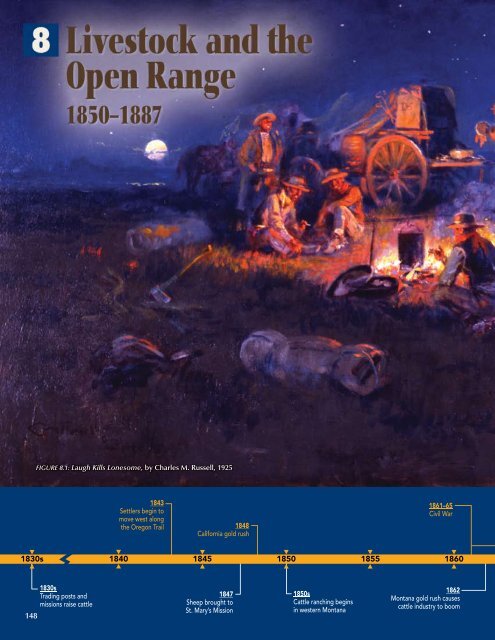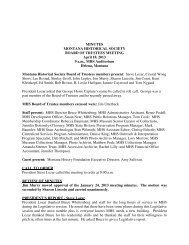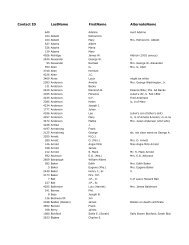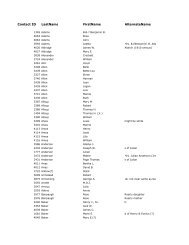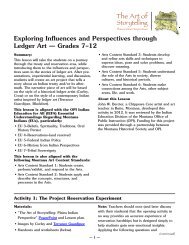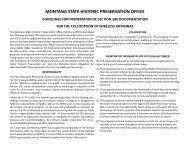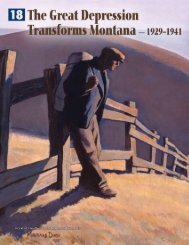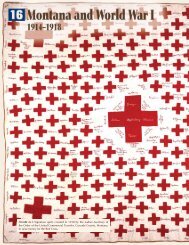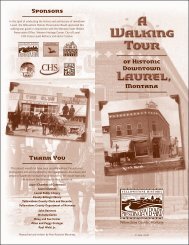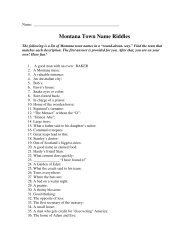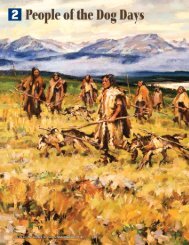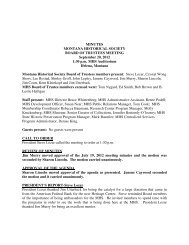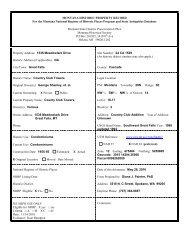148 1830s 1850 1840 1845 1855 1860 - Montana Historical Society
148 1830s 1850 1840 1845 1855 1860 - Montana Historical Society
148 1830s 1850 1840 1845 1855 1860 - Montana Historical Society
You also want an ePaper? Increase the reach of your titles
YUMPU automatically turns print PDFs into web optimized ePapers that Google loves.
<strong>148</strong><br />
FIGURE 8.1: Laugh Kills Lonesome, by Charles M. Russell, 1925<br />
<strong>1830s</strong><br />
Trading posts and<br />
missions raise cattle<br />
1843<br />
Settlers begin to<br />
move west along<br />
the Oregon Trail<br />
1848<br />
California gold rush<br />
1847<br />
Sheep brought to<br />
St. Mary’s Mission<br />
<strong>1850</strong>s<br />
Cattle ranching begins<br />
in western <strong>Montana</strong><br />
1861–65<br />
Civil War<br />
<strong>1830s</strong> <strong>1840</strong> <strong>1845</strong> <strong>1850</strong><br />
<strong>1855</strong> <strong>1860</strong><br />
1862<br />
<strong>Montana</strong> gold rush causes<br />
cattle industry to boom
1866<br />
First cattle<br />
drive from<br />
Texas into<br />
<strong>Montana</strong><br />
1868<br />
Barbed wire invented<br />
1869<br />
First transcontinental<br />
railroad completed<br />
1874–87<br />
Indian reservations<br />
made smaller<br />
1879<br />
Edison patents<br />
long-lasting light bulb<br />
ReAd To Find ouT:<br />
n What drew ranchers to <strong>Montana</strong><br />
Territory<br />
n What problems plagued the openrange<br />
cattle ranches<br />
n How the winter of 1886–87 changed<br />
life on the open range<br />
n How the brief open-range ranching<br />
days shaped life in <strong>Montana</strong> today<br />
The Big Picture<br />
The glory days of the open range were created—<br />
and quickly brought to an end—by the same<br />
forces that drive all life in <strong>Montana</strong>: water,<br />
weather, and the land.<br />
As the bison disappeared from the Northern Plains, a new<br />
way of life spread across the <strong>Montana</strong> grasslands: the life of<br />
the cattleman on the open range.<br />
<strong>Montana</strong> offered 40 million acres of rich grazing land with<br />
some of the best grasses in the West. By pushing American<br />
Indians onto shrinking reservations, the government opened<br />
up vast regions of this public resource. Investors from all<br />
over the world came to profit from the open range.<br />
The period of open-range ranching began and ended<br />
in less than 50 years. Yet it profoundly influenced life in<br />
<strong>Montana</strong>. The days of the open range left a lasting legacy<br />
(something handed down from the past) that continues to<br />
shape life here today.<br />
1880<br />
Artist Charles M. Russell<br />
arrives in <strong>Montana</strong><br />
1883<br />
Northern Pacific<br />
Railroad completes<br />
transcontinental route<br />
1883<br />
Fewer than 200<br />
bison remain on<br />
the Plains<br />
1889<br />
<strong>Montana</strong> becomes a state<br />
1883<br />
Copper boom begins in Butte<br />
1865 1870 1875 1880 1885<br />
1890<br />
1886–87<br />
Hard Winter<br />
149
FIGURE 8.2: Indian horsemen found<br />
cowboy work a good way to make<br />
money. American painter William<br />
Gollings (1878–1932) created this<br />
image, Cheyenne Cowboys, after<br />
working briefl y on sheep and cattle<br />
ranches in <strong>Montana</strong>, South Dakota,<br />
and Nebraska.<br />
1 5 0 P A R T 2 : A C E N T U R Y O F T R A N S F O R M A T I O N<br />
Grassland:<br />
The Main Character in the Story<br />
Ranchers found <strong>Montana</strong>’s grasslands to be superior<br />
to other areas of the West like Colorado<br />
or Wyoming. <strong>Montana</strong>’s winter snows are not as<br />
deep and do not last as long. Winds frequently<br />
blow the snow off the grasses, allowing cattle<br />
to feed all winter. And many streambeds thread<br />
through <strong>Montana</strong>, providing both water and shelter<br />
for the ranging cattle.<br />
But the heart of it all was the grass itself: blue<br />
grama, buffalograss, needle-and-thread grass,<br />
western wheatgrass, and other native species.<br />
These grasses cured (dried) standing up, so the<br />
winter snows did not fl atten them and cover<br />
them up, as they did back east. They provided<br />
nutritious forage (animal food for grazing) that<br />
fattened cattle even with no additional feed.<br />
Best of all, it was free.<br />
The federal government had claimed wide<br />
tracts of land from the Indian tribes—by treaty<br />
(an agreement between governments) and by<br />
force (see Chapter 7). The land could not be sold<br />
or homesteaded until it was surveyed (measured for mapping). Before<br />
the 1880s very little of the central and eastern plains had been surveyed,<br />
other than for the railroad lines. So the stockmen simply claimed it for<br />
their own. Like beaver to the fur companies and gold to the miners, the<br />
grass was free.<br />
The Birth of Open-range Ranching<br />
Cattle fi rst came to <strong>Montana</strong> in the <strong>1830s</strong> to supply trading posts and<br />
missions. In the <strong>1850</strong>s a fur trader named Richard Grant and his two<br />
sons, Johnny and James, started buying lame or exhausted cattle from<br />
wagon trains on the Oregon Trail. They drove them north into the Deer<br />
Lodge, Beaverhead, and Bitterroot Valleys to fatten. Then they drove the<br />
fresh cattle back south to the Oregon Trail, trading one fat animal for<br />
two weary ones. By 1858 the Grants and other former fur traders were<br />
grazing cattle throughout southwestern <strong>Montana</strong>.<br />
Then came the <strong>Montana</strong> gold rushes. Mining camps sprouted up.<br />
Timber camps spread into the woods. The population boomed, and<br />
the army brought in more soldiers to protect the new settlers. All these<br />
people had to eat. People quickly hunted out the wild game around the<br />
mining camps and army forts. The demand turned to beef. Ranching<br />
expanded quickly to feed the growing demand.
Some gold miners found the beef<br />
business more profi table than scratching<br />
for gold. In 1862 two businessmen<br />
named James and Granville Stuart drove<br />
76 cattle into Bannack and opened a<br />
butcher shop. They earned $300 (equivalent<br />
to $5,400 today) in two weeks.<br />
“<br />
The Government Takes More Indian Land<br />
As ranching and settlements expanded, stockmen pressured the federal government<br />
for more land. The government responded to ranchers’ demands.<br />
In 1874 President Ulysses S. Grant issued an executive order (an<br />
order issued by the president of the United States) shrinking the boundaries<br />
of the Blackfeet, Gros Ventre, Sioux, and Assiniboine reservation<br />
lands. By the early 1880s most of central <strong>Montana</strong> had become free<br />
grazing land for cattle.<br />
In 1882 the government pressured the Crow to cede (give up) the<br />
western portion of their reservation (land the tribe reserved for its own<br />
use through treaties). As soon as the government claimed these lands,<br />
ranchers rushed to fi ll them up with cattle.<br />
The Northern Cheyenne were able to protect their reservation. Their<br />
reservation agent did allow neighboring ranchers to lease grazing lands—<br />
When I fi rst reached <strong>Montana</strong>, the Deer<br />
Lodge Valley was one of the most beautiful<br />
stretches of bunch grass available. The grass<br />
waved like a huge fi eld of grain.”<br />
—CONRAD KOHRS, EARLY CATTLEMAN OF MONTANA<br />
FIGURE 8.3: In 1866 a German immigrant<br />
named Conrad Kohrs bought Johnny<br />
Grant’s ranch. Over the years Kohrs<br />
controlled more than a million acres of<br />
land in <strong>Montana</strong> and sometimes shipped<br />
10,000 cattle to market in a year. The<br />
ranch is now a national historic site,<br />
preserving the open-range cattle era<br />
for all Americans.<br />
8 — L I V E S T O C K A N D T H E O P E N R A N G E 1 5 1
FIGURE 8.4: Stockmen and<br />
the railroads pressured the<br />
government to negotiate for<br />
more tribal lands for grazing<br />
cattle and sheep. Between<br />
1870 and 1890 <strong>Montana</strong>’s<br />
Indian tribes lost millions<br />
of acres of reservation lands.<br />
1 5 2 P A R T 2 : A C E N T U R Y O F T R A N S F O R M A T I O N<br />
Indian Reservations in 1870 and 1890<br />
but he made it clear that the goal was for the Cheyenne ultimately to use<br />
the land themselves for their own cattle.<br />
By the early 1880s the railroads were also building through <strong>Montana</strong>.<br />
They, too, pressured Congress to open up Indian lands. Newspapers<br />
joined in, too, with editorials refl ecting how many non-Indians felt at the<br />
time. One editorial from the Helena Herald in the early 1880s said, “These<br />
ranges are needed for our cattle and they are of no use in the world to<br />
the Indians.”<br />
In 1887 the government again reduced the land reserved for the<br />
Blackfeet, Gros Ventre, Sioux, and Assiniboine, creating three small reservations<br />
(the Blackfeet, Fort Belknap, and Fort Peck Reservations). Eight<br />
years later the government once more pressured the Blackfeet, this time<br />
to sell 800,000 acres of their remaining reservation—an area that today<br />
includes Glacier National Park.<br />
The Longhorns Come North<br />
Most <strong>Montana</strong> outfi ts (ranching operations) in the 1870s ran breeding<br />
stock of shorthorn, Hereford, and Angus cattle. But as these herds spread<br />
north and east from the gold camps onto <strong>Montana</strong>’s plains, they met a<br />
rising tide of Texas longhorns driven in from the south.<br />
The fi rst Texas longhorn cattle drive happened in 1866. Nelson<br />
Story, a <strong>Montana</strong> miner, used his gold profi ts to buy 600 longhorns in<br />
Texas. He drove them north through Colorado and Wyoming, then into<br />
<strong>Montana</strong> along the Bozeman Trail.<br />
Not long after, the period of the great Texas cattle drives began in
Songs along the Trail<br />
earnest. Word spread throughout<br />
At night cowboys often sang to the cattle to calm them, trad-<br />
the West that <strong>Montana</strong> offered vast<br />
ing tunes and making up their own lyrics as opportunity and<br />
grazing lands that were free for<br />
imagination allowed. Some of their songs were ancient sea<br />
public use. Cattle operators in Texas,<br />
shanties with new words. Some were Mexican or Celtic (Irish,<br />
where the grazing lands already<br />
Scottish, or Gaelic) folk tunes. Cowboy Teddy Blue Abbott<br />
were overstocked, began driving<br />
remembered: “The singing was supposed to soothe the cattle,<br />
their herds north to <strong>Montana</strong>.<br />
and it did . . . The two men on guard would circle around with<br />
One young cowboy named<br />
their horses on a walk, if it was a clear night and the cattle<br />
Teddy Blue Abbott later remem-<br />
was bedded down and quiet. One man would sing a verse of a<br />
bered that while driving cattle north<br />
song, and his partner on the other side of the herd would sing<br />
to <strong>Montana</strong> he was hardly ever out<br />
another verse; and you’d go through a whole song that way.”<br />
of sight of another herd. One day,<br />
he said, “I could see seven herds behind<br />
us. I knew there were eight herds ahead of us, and I could see the<br />
dust from thirteen more of them on the other side of the river.” Since<br />
the typical herd included more than 2,000 head of cattle, Abbott counted<br />
more than 58,000 head on one section of trail.<br />
The 1880s: Cattle Boom on the Open Range<br />
The early 1880s were the heyday (peak years) of the open range—its<br />
time of greatest success and vigor. The populations boomed in the United<br />
States and Europe, creating an increasing demand for beef. The Northern<br />
Pacifi c Railroad, completed through <strong>Montana</strong> in 1883, gave ranchers<br />
easy access to markets across the country. And a series of mild winters<br />
led many newcomers to think <strong>Montana</strong> never had harsh weather.<br />
Working the Range<br />
As more outfi ts arrived in <strong>Montana</strong> Territory,<br />
cattlemen organized systems to manage the<br />
land. The territory was divided into grazing districts.<br />
Within each district, individual ranches<br />
claimed a customary range just by being the<br />
fi rst to graze there. Sometimes the ranch owner<br />
would homestead near a water source—a<br />
river, creek, lake, or stream—and build a rough<br />
ranch house there. Then he would publish a<br />
notice in the nearest weekly newspaper describing<br />
the boundaries of his range and listing<br />
his brand. Operators that let their herds graze<br />
without establishing a customary range were<br />
sometimes called grass pirates.<br />
Water was life on the dry plains, so the<br />
ranchers who controlled water sources controlled<br />
the land around them. By claiming<br />
FIGURE 8.5: At night cowboys took turns<br />
in pairs circling the herd to keep the<br />
cattle together. The “night hawk,” usually<br />
the youngest or most inexperienced<br />
cowhand, stayed up all night to guard<br />
the trail horses. He was the only cowboy<br />
on the cattle drive who got to sleep in.<br />
8 — L I V E S T O C K A N D T H E O P E N R A N G E 1 5 3
FIGURE 8.6: Cowboys had to have exceptional<br />
horsemanship skills, especially<br />
when cows or steers got feisty. But the<br />
horses had to know what they were<br />
doing, too. These horses are working<br />
together while their riders team-rope a<br />
steer. <strong>Montana</strong> artist Charles M. Russell<br />
painted this image in 1926.<br />
1 5 4 P A R T 2 : A C E N T U R Y O F T R A N S F O R M A T I O N<br />
a 360-acre homestead<br />
with a water source, a<br />
rancher could control<br />
thousands of acres of<br />
grazing land.<br />
Before barbed wire<br />
was invented in 1868, it<br />
was impossible to fence<br />
off all the grazing land a<br />
herd needed to survive.<br />
Plus, in the most arid<br />
(dry) areas, it took 250<br />
acres to feed a cow for<br />
a year. A herd of 10,000<br />
cattle needed 2.5 million<br />
acres of land to survive—and some outfi ts ran 40,000 cattle. This was<br />
why the open range was so important.<br />
The Roundup: Adventure on Horseback<br />
Free-range cattle drifted for miles and got mixed up with neighboring<br />
herds. So every spring and fall, ranch hands in each grazing district<br />
joined together for a roundup (a cooperative effort to round up all the<br />
cattle in a region, sort them out, brand the new calves, and trail each<br />
herd to its home range).<br />
A roundup usually lasted weeks and meant hard work for everyone.<br />
Cowhands were up at 4:00 a.m. to look for stray cattle and herd them<br />
back to the roundup area. There the cowboys sorted all the cattle into<br />
individual herds by their brands (marks burned into each animal’s hide<br />
that identifi ed what ranch it belonged to).<br />
The afternoon job was to brand all the calves born since the last<br />
roundup. When all the animals were sorted and branded, the hands<br />
trailed them to their home range. After the spring roundup, the cattle were<br />
turned out again for summer pasture. After the fall roundup, the animals<br />
ready for sale were trailed to the nearest railhead for shipping to market.<br />
Faces of the Range: Who They Were<br />
To investors far away, the promise of free access to grass, water, and<br />
land made the ranching business look pretty good. All across the West,<br />
from Texas to Canada, investors bought up or started ranches. Some<br />
of the biggest operations in <strong>Montana</strong> were owned by companies in<br />
Missouri, Nebraska, New Hampshire, and Texas, or by investors in<br />
England, Scotland, Norway, and France. Of the many fortunes made in<br />
the heyday of the open range, most of the riches went to stockholders<br />
who had never been to <strong>Montana</strong>.
There were large <strong>Montana</strong>-owned operations, too. Granville Stuart,<br />
Reese Anderson, and Conrad Kohrs owned a ranch that became the Pioneer<br />
Cattle Company. It expanded to 12,000 head by 1883. Frenchman Pierre<br />
Wibaux attracted investors from his home country to help him build a<br />
large operation in the Beaver Valley along the <strong>Montana</strong>-Dakota border.<br />
Unlike many foreign investors, Wibaux adopted <strong>Montana</strong> as his home.<br />
But most of the cattle ranches were small operations. Soon there were<br />
nearly 50,000 different ranchers grazing cattle on the open plains. They<br />
grazed herds large and small, ranging from 50 head to 40,000 head. Some<br />
of them failed, some became rich, and some made a life for themselves<br />
that their descendants carry on today.<br />
Ranches on the Reservations<br />
As American Indians were forced onto reservations, some became ranchers.<br />
Ranching helped Indian tribes expand their economic opportunities,<br />
maintain their cultures, and gain independence from government control.<br />
It provided a new way to make a living after the bison were gone.<br />
Ranching became very important to reservation economies.<br />
In 1882 a journalist visiting the Flathead Reservation reported seeing<br />
“thousands of sleek cattle and fi ne horses” that the Salish, Kootenai, and<br />
Pend d’Oreille owned. By 1900 nearly one-quarter of the families on the<br />
Blackfeet Reservation owned cattle. Together they registered more than<br />
500 brands and operated 200 mowing machines to cut hay for their<br />
stock. They raised cattle for the Chicago market and<br />
horses for <strong>Montana</strong>.<br />
In 1903 the Northern Cheyenne purchased 40 bulls<br />
and 1,000 cows. Ten years later the tribe had built a<br />
herd of 12,000 head. Their cattle earned some of the<br />
highest prices on the Chicago market. Indians on the<br />
Fort Peck and Fort Belknap Reservations started ranching<br />
later.<br />
Sometimes there were problems. Neighboring ranchers<br />
often let their cattle trespass on reservation lands<br />
to graze, competing with the tribal herds. In 1904 the<br />
Blackfeet tribe built a fence around their entire reservation<br />
to stop the trespassing. The Blackfeet wanted to<br />
save the grass for their own cattle. But even a fence did<br />
no good—ranchers simply cut the wire and let their<br />
cattle onto the reservation.<br />
Nevertheless, many Indian ranchers preferred ranching<br />
over farming. They liked working outdoors, where<br />
they could apply their traditional skills of horsemanship.<br />
As one historian wrote, Indians “could be like white<br />
men and yet not be white men” through cattle ranching.<br />
“They were fi nding new ways to remain Indians.”<br />
FIGURE 8.7: Cattle ranching fi t well with<br />
Plains Indians’ experience with animals<br />
and the value many Indians placed on<br />
horses, movement, and freedom. This<br />
photo shows Crow Indian cowboys<br />
branding cattle in 1890.<br />
8 — L I V E S T O C K A N D T H E O P E N R A N G E 1 5 5
“<br />
Old-timers have told<br />
all about stampedes<br />
and swimming rivers<br />
and what a terrible<br />
time we had, but they<br />
never put in any of<br />
the fun, and fun was<br />
at least half of it.<br />
”<br />
—TEDDY BLUE ABBOTT<br />
FIGURE 8.8: Even the best horsemen had<br />
to be prepared for a skittish horse. In<br />
his painting Bronc to Breakfast, master<br />
storyteller Charles M. Russell portrays<br />
one of the hazards of an unruly mount.<br />
1 5 6 P A R T 2 : A C E N T U R Y O F T R A N S F O R M A T I O N<br />
Cowboys: Young Adventurers on Horseback<br />
The daily work of the open range was the realm of the cowboy—young,<br />
single, physically capable, and at ease on horseback. Many cowboys<br />
were American Indian, Métis, Mexican, or African American. There were<br />
also plenty of farm boys from eastern states, and even some sons of<br />
English gentlemen, who came west for adventure.<br />
Like fur trapping and prospecting, cowboying attracted the young.<br />
Many were teenagers. Charlie Russell was 16 when he fi rst signed on as a<br />
cowboy. James Mooney became a cowboy at 13 and was trail boss at 19.<br />
Few men over age 30 had the strength to do the work required. Cowboys<br />
rode in bitter cold and wicked heat, pushed through blizzards and dust<br />
storms, and endured snake bites, kicking horses, bugs, and driving wind.<br />
But cowboying beat other low-wage jobs at the time. Cowboys could<br />
earn $20 to $40 per month plus grub (food), which is equal to about<br />
$600 today. With few opportunities to spend money on the open range,<br />
some cowboys saved enough to buy their own outfi ts.<br />
And many of them simply loved life in the outdoors. They liked the<br />
adventure, the freedom, the challenge of working with animals, and the<br />
beauty of the open spaces. They enjoyed the camaraderie (friendship<br />
with other cowboys) built by hard work outdoors.<br />
Cowboys often eased their boredom by pulling pranks, like slipping<br />
a lizard into another’s bedroll or putting a greenhorn (beginner) on<br />
a horse known for throwing its riders. One outfi t loosened the cinch<br />
on a cowboy’s saddle while he was in town, so when he mounted his<br />
horse and spurred it forward,<br />
he and the saddle<br />
slid off backward right<br />
in front of the townsfolk.<br />
Cowboys liked to tell<br />
stories on one another,<br />
and any man who could<br />
not take the teasing was<br />
considered too thinskinned<br />
to work with.<br />
Women and<br />
Family Life<br />
Like everyone else on a<br />
ranch, women worked<br />
hard. They washed<br />
clothing and household<br />
linens by hand in washtubs<br />
outside and hung<br />
them on clotheslines,
fences, or bushes to dry. They served as doctor and pharmacist for the<br />
cowboys or for sick neighbors. They cooked for family members and<br />
the hired help. They often kept the accounts. They grew vegetables and<br />
raised chickens, milk cows, pigs, turkeys, and geese to eat and for sale.<br />
Many women mended fences and herded cattle right alongside the men.<br />
They helped with branding and haying. “I was just like a hired man,”<br />
remembered ranch wife Katie Adams.<br />
Some ranch women found the life terribly lonely. Grace Bendon, who<br />
lived on a ranch near Glendive, remembered that non-Indian women<br />
were a real curiosity on the open range. “One winter I was the only<br />
white woman on a stream 90 miles long<br />
and I did not see a white woman for six<br />
months,” she recalled.<br />
Other women enjoyed the natural<br />
beauty and expansive horizons. Britishborn<br />
Evelyn Cameron, who ranched with<br />
her husband on the Yellowstone River,<br />
photographed and wrote enthusiastically<br />
about the wide-open <strong>Montana</strong> landscape.<br />
“I think the river is the next best thing to<br />
the sea,” she wrote to her mother. She<br />
loved the ranch even though “everything<br />
down to the smallest tin tack” had to be<br />
hauled in from Terry, 14 miles away.<br />
Most ranch children worked, too.<br />
They were an important part of the family<br />
business. A fi ve-year-old might split<br />
kindling. A nine-year-old might drive a<br />
team of horses pulling a hay rake or herd<br />
livestock on horseback all day.<br />
Sheep on the<br />
<strong>Montana</strong> Rangeland<br />
Sheep came to <strong>Montana</strong> at about<br />
the same time cattle did. Jesuit<br />
priest Father Anthony Ravalli<br />
trailed sheep to St. Mary’s Mission<br />
in the Bitterroot Valley in 1847.<br />
The sheep industry began<br />
in earnest after 1869, when two<br />
ranchers drove 1,500 sheep<br />
from Oregon to the Beaverhead<br />
Valley near Dillon. Soon after<br />
that, the Poindexter-Orr cattle<br />
Musical Gatherings:<br />
The Highlight of Ranch Life<br />
“Parties were held every so often in our countryside by<br />
anyone who had a room big enough—and it didn’t have<br />
to be very big . . . people would drive to them from miles<br />
and miles away, all bundled up in a wagon with babies in<br />
their arms. At most of the dances the babies were simply<br />
laid on the floor under the benches where the spectators<br />
sat. They would sprinkle corn meal on the rough floors<br />
to make them slippery, and the men tramping in and out<br />
would track in snow which would mix with the corn meal<br />
to make a kind of slush, so your skirt would be wet way<br />
above the hem, but nobody stopped dancing for that. The<br />
few women present would be danced half to death. And<br />
it lasted until morning, because you couldn’t drive home<br />
anyway until it was daylight.”<br />
—NANNIE T. ALDERSON, WHO RANCHED NEAR MILES CITY IN THE 1880S<br />
Catalogs Were Textbooks<br />
and “Books of Wonder”<br />
“We had been getting the Montgomery Ward catalog since 1885.<br />
It is impossible to exaggerate the importance of the part played<br />
by this book of wonder in the children’s lives. They pored over<br />
it endlessly; before they could read, the pictures were there to<br />
dazzle them . . . The catalogue is well named the “wish book”<br />
by country people . . . In time they learned to spell words out<br />
of it. They never went to school until we moved to Miles City . . .<br />
All they knew up to that time was reading, as taught by Montgomery<br />
Ward, and printing block letters, which I taught them.”<br />
—NANNIE T. ALDERSON<br />
8 — L I V E S T O C K A N D T H E O P E N R A N G E 1 5 7
FIGURE 8.9: Ranch children played with<br />
the materials at hand, like a saddle thrown<br />
over a fence or a wagon harnessed to a<br />
young goat. These two, Lucille and Paul<br />
Burt, were children of a prominent sheep<br />
rancher near Terry. They owned the fi rst<br />
bicycle in the county.<br />
FIGURE 8.10: Sheepherders tended their<br />
fl ocks all winter. They cooked, slept,<br />
and stayed warm in sheep wagons with<br />
multilayered canvas tops. Inside was a<br />
stove, dish cupboard, storage cupboard,<br />
bench, and bed. When it was time to<br />
move the fl ock to new grazing ground,<br />
the herder hitched the wagon to a team<br />
of horses and moved camp.<br />
1 5 8 P A R T 2 : A C E N T U R Y O F T R A N S F O R M A T I O N<br />
partnership brought in 2,467 sheep to add<br />
to their livestock.<br />
Sheep spread eastward along with the<br />
cattle. By early 1879 there were 15,000 sheep<br />
in the Smith River region and 60,000 on the<br />
Musselshell River.<br />
Many <strong>Montana</strong> ranchers in western<br />
and central <strong>Montana</strong> raised both sheep and<br />
cattle, and in many ways the two industries<br />
grew together. Both relied on the free<br />
grasses of the open range. During the good<br />
years, both industries made good profi ts. In<br />
bad years, confl icts sometimes arose as cattle and sheep competed for<br />
rangeland. In other regions—Wyoming, for example—those confl icts<br />
erupted into violence. But in <strong>Montana</strong>, so many ranchers ran both<br />
cattle and sheep that there were far fewer confl icts between cattlemen<br />
and sheepmen.<br />
Sheep also attracted many small investors. Sheep weathered <strong>Montana</strong><br />
winters well, could be raised at lower cost than cattle, and yielded annual<br />
profi ts from the wool. Annual shearings made sheep more affordable<br />
than cattle, which had to be fattened two or three years before they<br />
could be sold.<br />
The Sheepherder:<br />
Experienced Immigrants Come to the Plains<br />
Sheepherders were a different breed from cowboys but were just as<br />
important to <strong>Montana</strong>’s early livestock days. Most of them were experienced<br />
sheepmen who came from other countries: Scotland, Portugal,<br />
the Basque region between Spain and<br />
France, Mexico, and occasionally<br />
Norway, Ireland, or England.<br />
The sheepherder had to be selfreliant.<br />
He often worked alone with his<br />
dog for months on end. He had to cook,<br />
clean, mend, and provide for himself<br />
while out with the fl ocks. Though he<br />
traveled on horseback, he did much of<br />
his work on foot among fl ocks of 1,500<br />
to 3,000 sheep. He protected his fl ocks<br />
from bears, coyotes, and wolves, as well<br />
as from pests, parasites, and poisonous<br />
plants. Most of a sheepherder’s work entailed<br />
watching—for danger, for weather,<br />
for predators, for any kind of mishap.<br />
Sheepherders did not become the
omantic legends that cowboys became. But<br />
sheepdogs—those loyal, intelligent, often heroic<br />
workers of the open range—sometimes did earn<br />
legendary status. Sheepdogs were invaluable for<br />
keeping the herds together, for warning off predators,<br />
and for keeping lambs out of trouble.<br />
“Sometimes it seemed as if a dog could read<br />
the herder’s mind,” remembered Henry and<br />
John Murray, who grew up on a Judith Basin<br />
sheep ranch. “The dogs worked with voice commands<br />
as long as they could hear the herders<br />
and watched for arm signals which the dogs<br />
could see a mile or so away.”<br />
“<br />
Horse Raising on the Reservation and Off<br />
Horses have been part of life on the Northern Plains since the 1700s.<br />
Many ranches bred horses along with cattle and sheep. <strong>Montana</strong>’s<br />
horses soon gained national attention for their quality both as working<br />
mounts and as racehorses.<br />
Many Indian ranchers preferred raising horses over cattle. Traditionally,<br />
an Indian family’s horses were a measure of its wealth. Many Indians<br />
thought there was more dignity in raising horses than cattle. As Crow<br />
Indian historian Joseph Medicine Crow wrote, “To be a Crow rancher in<br />
those days was to raise horses.”<br />
British ranchers in <strong>Montana</strong> often raised horses, too. Some tried to<br />
make their fortunes raising ponies for polo (a British game played on<br />
horseback). Others raised war horses to sell to the military.<br />
One wealthy miner named Noah<br />
Armstrong began raising and breeding<br />
thoroughbred racehorses on his<br />
farm near Twin Bridges in 1885. One<br />
of his prize horses, named Spokane,<br />
won the 1889 Kentucky Derby. In the<br />
1890s Marcus Daly, a copper baron,<br />
built the Bitterroot Stock Farm, where he<br />
raised thoroughbreds, pacers, and highquality<br />
cavalry horses that he sold to<br />
the government.<br />
And, of course, ranchers raised horses<br />
to work the land—cow ponies for cowboys<br />
to ride and large, heavy draft<br />
horses to pull farm equipment. <strong>Montana</strong><br />
ranches relied on horses until the 1920s,<br />
when automobiles and tractors began to<br />
take over.<br />
One time . . . [while I was] visiting a<br />
herder while tending camp he turned<br />
to his dogs and said in a conversational<br />
tone, ‘It is time for your bath now, boys.’<br />
We were well out on the prairie a mile<br />
or more from any water, but the dogs<br />
took off in the direction of water. In an<br />
hour or so they returned, plainly evident<br />
that their mission had been fulfi lled.<br />
”<br />
—HENRY T. MURRAY, WHO GREW UP ON A SHEEP RANCH IN THE JUDITH BASIN<br />
FIGURE 8.11: Shearing time was a period<br />
of sweaty, backbreaking work for the<br />
shearers. Rancher George Burt (in the<br />
black vest) was one of the fi rst to try<br />
mechanical shearing. Note the power<br />
shears hanging from wheels at each<br />
shearer’s stall.<br />
8 — L I V E S T O C K A N D T H E O P E N R A N G E 1 5 9
FIGURE 8.12: Photographer Evelyn<br />
Cameron climbed into her neighbors’<br />
horse corral to photograph them working<br />
with new horses. The neighbors, Myrtle,<br />
May, and Mabel Buckley, were widely<br />
admired horsewomen.<br />
FIGURE 8.13: Stockmen’s associations<br />
not only helped solve common problems<br />
but also promoted their industries. This<br />
silk ribbon commemorates the Fifth<br />
Annual Meeting of the Pacifi c Northwest<br />
Woolgrowers’ Association, held in<br />
Helena in 1902.<br />
1 6 0 P A R T 2 : A C E N T U R Y O F T R A N S F O R M A T I O N<br />
Problems of<br />
the Open Range<br />
The open range was free and wide open,<br />
but it also presented some problems<br />
for ranchers. Prairie fi res swept across<br />
the range. Wolves, coyotes, and other<br />
predators sometimes killed signifi cant<br />
numbers of animals. Winter blizzards,<br />
spring fl oods, lightning, insects, and hail<br />
could be devastating. And none of the<br />
ranchers could entirely control land<br />
they did not own.<br />
Sometimes unbranded calves became<br />
mavericks (unidentifi ed calves<br />
that wandered off from their mothers). Ranchers generally agreed that a<br />
maverick became the property of the ranch onto which it strayed. This<br />
agreement caused problems when some ranchers began “mavericking”—indiscriminately<br />
branding any stray calf they saw.<br />
Cattle rustling (rounding up horses or cattle for thievery) was far<br />
too easy on the open range. Rustlers rounded up branded cattle, altered<br />
the brands, and quickly led them across the border into Dakota Territory<br />
or Canada for sale. Law enforcement was diffi cult over such vast, open<br />
distances. Some cattlemen illegally took the law into their own hands.<br />
Most notorious was a group of ranchers called “Stuart’s Stranglers”<br />
(because they were organized by Granville Stuart). The Stranglers killed<br />
at least 15 suspected cattle rustlers in <strong>Montana</strong> in 1884, then proceeded<br />
across the border into Dakota and killed even more.<br />
But the worst problem was overgrazing. Each rancher wanted to expand<br />
his or her own herd. There was no authority to determine when<br />
there were more cows and sheep feeding in a region than the grassland<br />
could sustain.<br />
Ranchers Organize to Solve Problems<br />
It did not take long for ranchers to realize that there were some problems<br />
they could not deal with on their own. To handle common diffi culties,<br />
stockmen and sheep ranchers organized into associations. Cattle ranchers<br />
formed the <strong>Montana</strong> Stockgrowers Association, and the sheepmen organized<br />
to form the <strong>Montana</strong> Wool Growers Association. Together these<br />
groups wielded enough economic and political power to get attention from<br />
the territorial legislature (the branch of government that passes laws).<br />
These associations worked with the legislature to pass laws regulating<br />
grazing on public land. They hired detectives to check brands on<br />
cattle and pressured the state to register brands. They persuaded the<br />
legislature to hire a veterinarian to help solve disease problems and to
create a Board of Stock Commissioners to enforce branding and other<br />
laws of the open range.<br />
The Hard Winter of 1886–87<br />
Even the ranching organizations could not prevent overgrazing. And<br />
because the open range was a common resource, no individual company<br />
was motivated to conserve or protect the water, grasses, or soils.<br />
Spring of 1885 found 500,000 head of cattle on the <strong>Montana</strong> range.<br />
The grasses became seriously depleted. That autumn was unusually dry.<br />
Water holes shrank and disappeared. Range fi res burned up large sections<br />
of cured grass. The open range was headed for disaster.<br />
In the spring of 1886, 100,000 more cattle and large herds of sheep<br />
arrived on the <strong>Montana</strong> plains. After a hot, dry summer, winter came<br />
early, with heavy snows and fi erce winds that made the snow as hard<br />
as cement. Little had been done to put up hay for winter feeding.<br />
A thaw came in December. When it froze again, ice caked the exposed<br />
clumps of grasses. The weakened cattle could not paw through the ice to<br />
get at the grass. In February a deep freeze returned. Some ranchers reported<br />
temperatures of 63°F below zero. Despite some heroic efforts by cowhands<br />
across the region, tens of thousands of cattle froze or starved to death.<br />
“Starving cattle staggered through village streets, collapsed and died in<br />
dooryards,” wrote historian Joseph Kinsey Howard about the winter of<br />
1886–87. “Five thousand head invaded the outskirts of the newborn city<br />
of Great Falls, bawling for food. They snatched up the saplings [young<br />
trees] the proud city had just planted, gorged themselves upon garbage.”<br />
Some experts estimated that <strong>Montana</strong> lost 362,000 head of cattle that<br />
winter—60 percent of the <strong>Montana</strong> herds. Losses were greatest in the<br />
eastern part of the state, where some cattle companies lost 90 percent of<br />
their herds. Smaller, more experienced ranchers in central <strong>Montana</strong> lost<br />
FIGURE 8.14: Cattle died by the thousands<br />
during the winter of 1886–87.<br />
Toward the end of that winter, Charles<br />
M. Russell painted this watercolor,<br />
Waiting for a Chinook. (A chinook is<br />
a warm winter wind.) The powerful<br />
image was published widely, launching<br />
Russell’s career as an artist.<br />
8 — L I V E S T O C K A N D T H E O P E N R A N G E 1 6 1
1 6 2 P A R T 2 : A C E N T U R Y O F T R A N S F O R M A T I O N<br />
far fewer—about 40 percent of their cattle. There were also dishonest<br />
ranch managers who reported huge losses to their owners to cover up<br />
for their own mismanagement of records. So it was impossible to count<br />
how many animals actually died that winter.<br />
The winter of 1886–87 was a turning point for <strong>Montana</strong>’s cattle<br />
industry. Never again would ranchers operate so recklessly on the<br />
Northern Plains.<br />
Recovery Came Quickly—with Tough Lessons Learned<br />
The disastrous winter of 1886–87 changed the cattle industry on the<br />
Northern Plains. Losses from that terrible winter drove hundreds of<br />
outfi ts out of business. Many of them were big ranches that focused on<br />
short-term profi ts.<br />
The outfi ts that survived ran things differently from then on. They<br />
began putting up hay and planting barley for feed to see the animals<br />
through the winter. They reduced the size of their herds and worked<br />
instead to improve the quality of their stock through careful breeding.<br />
Ranchers realized they had to start caring for water, soil, and grasses<br />
to remain prosperous. Many ranchers fenced grazing ranges to keep<br />
their cattle from wandering. Fences also helped prevent overgrazing by<br />
keeping other people’s cattle out.<br />
Some ranchers even profi ted from the Hard Winter. When bankrupt<br />
operations sold off their remaining cattle, the more carefully managed<br />
ranches bought up their livestock at low prices. With less beef on the<br />
market, their profi ts increased. With fewer cattle on the range, <strong>Montana</strong>’s<br />
grasses recovered quickly.<br />
Technology helped, too. Improved syringes (injection needles)<br />
helped stockmen inoculate cattle against diseases. Windmills to pump<br />
water, barbed wire for fencing, and new equipment like fence-post hole<br />
diggers, mowing machines, and hay rakes made ranch management<br />
easier. Some large operators, like the Frenchman Pierre Wibaux, found<br />
new investors and continued to grow. But after 1887 <strong>Montana</strong>’s cattle<br />
ranches were mostly in the hands of smaller, locally owned outfi ts.<br />
Sheep had weathered the Hard Winter much better than cattle had,<br />
so sheep ranching increased dramatically. Besides, ranchers learned that<br />
it paid to run two kinds of livestock. If cattle prices were depressed,<br />
they could still make money from wool and mutton (sheep meat).<br />
<strong>Montana</strong>ns expanded their sheep herds, and new investors appeared on<br />
the scene. By 1900 <strong>Montana</strong> was the nation’s top sheep-growing state,<br />
with 6 million sheep. And by 1904 it became the nation’s largest wool<br />
producer, shipping out 37,773,000 pounds of wool.<br />
The open-range system that began with such optimism in the 1870s<br />
lasted barely until 1900. A stockman either sold out or adapted to his<br />
new circumstances, becoming a combination of farmer/rancher. He<br />
(and sometimes she) continued to graze cattle and sheep in fenced
pasturage but also planted and harvested hay, barley, wheat, and other<br />
crops. Some ranches in northeast <strong>Montana</strong> continued the open-range<br />
system. But increasingly, roads, railroads, miles and miles of barbed wire<br />
fences, and homesteads hemmed in the wide-open grasslands.<br />
The Legacy of the Open Range<br />
As short-lived as the open-range era was, it left a lasting legacy.<br />
Hollywood made hundreds of movies about the cowboy—the expert,<br />
capable loner on horseback with his cowboy boots, his hat tipped low<br />
over his brow, and his reputation for honesty and straightforwardness.<br />
He is celebrated in country-and-western music, in cowboy poetry, and<br />
in clothing stores all across the country. Politicians wear cowboy boots<br />
to indicate that they are “down home” <strong>Montana</strong>ns. Country singers wear<br />
Stetson hats to identify themselves with a certain audience of people.<br />
One of the most sensational legacies of the open range is the rodeo.<br />
The word rodeo is Spanish, meaning “gather together.” Rodeos originated<br />
in Mexico with the vaqueros (Spanish for “cowboys”) and moved<br />
north with the cowboy culture.<br />
The fi rst rodeos were simple competitions at roundup time. Cowboys<br />
competed against one another to showcase their everyday skills on<br />
horseback—bucking horse contests, roping and cutting competitions,<br />
and horse races. Spectators bet on the winners, and cowboys often<br />
went home from roundup with their winnings in their pockets. When<br />
the years of open-range cowboying ended, cowboys began joining<br />
FIGURE 8.15: Cattle will drift for miles<br />
looking for shelter in a blizzard.<br />
Cowboys sometimes risked their lives<br />
trying to keep their animals from freezing<br />
to death. American painter Robert<br />
Lindneaux (1871–1970) painted this<br />
image, titled Drifting in a Blizzard,<br />
<strong>Montana</strong>, in 1926.<br />
8 — L I V E S T O C K A N D T H E O P E N R A N G E 1 6 3
FIGURE 8.16: Fanny Sperry Steele was<br />
one of <strong>Montana</strong>’s most famous women<br />
rodeo stars. She grew up on a ranch<br />
near Helena, where her mother taught<br />
her to ride as a toddler by plunking her<br />
on a horse and telling her, “DON’T fall<br />
off.” She twice won the title “Ladies<br />
Bucking Horse Champion of the World.”<br />
Here she rides a bronc named Dismal<br />
Dick at the Windham Roundup in 1920.<br />
1 6 4 P A R T 2 : A C E N T U R Y O F T R A N S F O R M A T I O N<br />
professional rodeos. These rodeos appealed to Americans fascinated by<br />
cowboys and the Wild West.<br />
Dude ranches also profi ted from Americans’ fascination with the open<br />
range. Across <strong>Montana</strong>, ranches opened their doors to vacationers who<br />
wanted to experience the West. These vacationers were known as dudes,<br />
so the ranches that hosted them became known as dude ranches.<br />
<strong>Montana</strong>’s fi rst dude ranch probably opened in the 1890s. The industry<br />
grew, especially when low prices for beef made it hard to make<br />
a living raising cattle. By the 1930s there were over 150 dude ranches<br />
in <strong>Montana</strong>. Today dude ranching is an important part of <strong>Montana</strong>’s<br />
tourism industry.<br />
The Open Range Shaped Our <strong>Montana</strong><br />
If you live in ranching country, you have a lot in common with people<br />
living during the era of the open range. Ranchers today drive pickup<br />
trucks, work computers, and implant computer chips in their cattle for<br />
identifi cation. Yet they face many of the same challenges as their ancestors<br />
did: isolation, unpredictable weather, unending hard work, changing<br />
market prices, even cattle rustling. Like their forebearers (ancestors),<br />
their lives are shaped by land, weather, and outside market conditions.<br />
And they are continually learning to be better stewards (caretakers) of<br />
the land, plants, and animals.<br />
Craig and Tonya Martin raise cattle, sheep, and four children on a<br />
Wheatland County ranch that has been in Craig’s family since 1889.<br />
They say they like living “25 miles from a grocery store, and 100 miles<br />
from people.”<br />
Even working constantly, their biggest challenge is fi guring out how<br />
to make a living. “You have to be ingenious [imaginative] and industrious<br />
[hard-working], or your place is on the farm auction sale,” Craig<br />
says. They started an excavation business<br />
to earn more income.<br />
High costs of land and fuel, the need<br />
for a lot of land, and low market prices<br />
keep most of today’s ranches from expanding.<br />
“The older ranchers say there’s<br />
no way they could get where they are<br />
today if they had to buy their land now,”<br />
Craig said. “The returns on our work are<br />
so low, probably most of us could make<br />
more money if we sold our places and<br />
put the money in a savings account.<br />
“You do it for the love of it.”<br />
This love—of the land and the work—<br />
is one of the most important legacies of<br />
<strong>Montana</strong>’s ranching heritage.
Expressions of the People<br />
The Art of<br />
Charles M. Russell<br />
In 1880 Charles Marion Russell came to the<br />
<strong>Montana</strong> range. The son of a wealthy St. Louis<br />
businessman, he was 16 and eager for<br />
adventure. Two years later he signed on<br />
as a horse wrangler on a cattle drive.<br />
He was not a particularly good roper<br />
or rider, but the other cowboys liked<br />
him because he could draw and tell<br />
good stories. He was such a good<br />
storyteller that when he started talking<br />
all the other cowboys gathered<br />
around. A fellow cowboy named I. D.<br />
O’Donnell said, “In the evenings in<br />
the bunk house the crowd usually got<br />
to spinning yarns and telling stories or<br />
singing songs. Charlie would be mum<br />
[silent] until everyone was fi nished and<br />
then he would tell his story that out<br />
classed them all, and then he was mum.”<br />
During the Hard Winter of 1886–87,<br />
Russell was working at the O-H Ranch.<br />
When a cattleman wrote the O-H asking<br />
about the condition of its herds that<br />
winter, Russell answered with a picture of<br />
a starved and near-frozen steer, circled by<br />
wolves. His watercolor, Waiting for a Chinook,<br />
started Russell on his career in art.<br />
FIGURE 8.17: Charles M. Russell wrote and<br />
illustrated this letter to a friend in about 1914.
Russell later moved to Great Falls and set up a studio.<br />
He gained an international reputation as a cowboy artist,<br />
preserving in his paintings, sculptures, and stories the<br />
spirit, activities, and details of a way of life in the West that<br />
already was quickly disappearing. A few of his paintings<br />
illustrate this chapter.<br />
Russell once said, “Any man that can make a living<br />
doing what he likes is lucky, and I’m that.” He created<br />
more than 4,000 works of art in his lifetime. When he died<br />
in Great Falls in 1926, all of <strong>Montana</strong> mourned his passing.<br />
FIGURE 8.18: Many western<br />
artists could only imagine life<br />
in the Old West, but Charlie<br />
Russell often painted from<br />
his own experiences. He also<br />
created paintings of stories he<br />
heard from his Indian friends.<br />
This photo shows Russell<br />
working on his painting The<br />
Lewis and Clark Expedition,<br />
now in the collection of the<br />
Gilcrease Museum of<br />
Art in Tulsa, Oklahoma.
CHeCK FoR undeRSTAndinG<br />
1. Defi ne: (a) forage; (b) cede; (c) greenhorn;<br />
(d) mavericks; (e) outfi t; (f) vaquero<br />
2. Identify: (a) Conrad Kohrs; (b) Granville Stuart;<br />
(c) Evelyn Cameron; (d) Charles M. Russell<br />
3. Why did ranchers value <strong>Montana</strong> grasslands?<br />
4. How did the open-range policy affect Indians?<br />
5. What were the main reasons for the increase in<br />
the cattle industry?<br />
6. What are some of the differences between cattle<br />
and sheep ranching?<br />
7. What other animal industry developed with<br />
the growth of the cattle and sheep industries?<br />
8. What were some of the problems ranchers<br />
faced with the open range?<br />
9. What was the primary change in the cattle<br />
industry as a result of the Hard Winter of<br />
1886–87?<br />
10.<br />
What are some of the legacies of the open<br />
range?<br />
CRiTiCAL THinKinG<br />
1. Analyze the advantages and disadvantages of<br />
the open range for ranchers, the environment,<br />
and Indian tribes.<br />
2. Would you have wanted to live on a <strong>Montana</strong><br />
ranch during the 1880s? Why or why not?<br />
3. An 1880s Helena Herald editorial said, “These<br />
ranges are needed for our cattle and they are<br />
of no use in the world to the Indians.” How<br />
would you respond to this if you were an<br />
Indian leader at the time?<br />
4. Compare the lives of cowboys to the lives of<br />
sheepherders. Why might someone chose one<br />
life over the other? Why do you think sheepherding<br />
has never captured the imagination of<br />
people the way cowboying has?<br />
5. Look back at the Charles M. Russell paintings<br />
that illustrate this chapter. Do you think<br />
they offer a realistic picture of life on the open<br />
range? Why or why not?<br />
CHAPTeR 8 ReVieW<br />
PAST To PReSenT<br />
1. Compare cattle ranching today with cattle<br />
ranching 100 years ago. What has remained<br />
the same and what has changed? For example,<br />
think about feeding, vaccinations, processing,<br />
and marketing as well as procedures for<br />
roundups, calving, and branding.<br />
MAKe iT LoCAL<br />
1. Look for things in your town that refl ect<br />
<strong>Montana</strong>’s ranching heritage, such as advertisements,<br />
business names, school mascots, street<br />
names, and so forth. List as many as you can.<br />
2. Visit a local rancher and learn about ranching<br />
in your area today<br />
eXTenSion ACTiViTieS<br />
1. Write a poem about the cowboy life using<br />
cowboy slang.<br />
2. Working in groups, create a cattle ranch.<br />
Choose a name, a brand, the area in which<br />
you are located, the number of acres and cattle<br />
you have, and so forth. Write a paragraph<br />
explaining some of the situations you face.<br />
3. Research and write a report or create a<br />
presentation on the <strong>Montana</strong> Stockgrowers<br />
Association or the <strong>Montana</strong> Wool Growers<br />
Association.<br />
4. Research the lives of <strong>Montana</strong> ranch women<br />
involved in the early ranching days. Write a<br />
report, give an oral presentation, or make a<br />
poster about your fi ndings.<br />
5. Investigate the controversies surrounding<br />
modern rodeos. For a class debate, research<br />
what animal rights groups say about cruelty<br />
to animals in the rodeo circuit and how<br />
rodeo associations respond to these criticisms.<br />
8 — L I V E S T O C K A N D T H E O P E N R A N G E 1 6 7
Credits<br />
The following abbreviations are used in the credits:<br />
BBHC Buffalo Bill <strong>Historical</strong> Center, Cody, Wyoming<br />
GNPA Glacier National Park Archives<br />
LOC Library of Congress<br />
MAC <strong>Montana</strong> Arts Council, Helena<br />
MDEQ <strong>Montana</strong> Department of Environmental Quality, Helena<br />
MDT <strong>Montana</strong> Department of Transportation, Helena<br />
MFWP <strong>Montana</strong> Fish, Wildlife and Parks, Helena<br />
MHS <strong>Montana</strong> <strong>Historical</strong> <strong>Society</strong>, Helena<br />
MHSA <strong>Montana</strong> <strong>Historical</strong> <strong>Society</strong> Archives, Helena<br />
MHSL <strong>Montana</strong> <strong>Historical</strong> <strong>Society</strong> Library, Helena<br />
MHS Mus. <strong>Montana</strong> <strong>Historical</strong> <strong>Society</strong> Museum, Helena<br />
MHS PA <strong>Montana</strong> <strong>Historical</strong> <strong>Society</strong> Photograph Archives, Helena<br />
MSU COT <strong>Montana</strong> State University College of Technology, Billings<br />
NMAI National Museum American Indian, Smithsonian Institution,<br />
Washington, D.C.<br />
MSU Billings Special Collections, <strong>Montana</strong> State University<br />
Billings Library<br />
NARA National Archives and Records Administration<br />
NPS National Park Service<br />
NRIS Natural Resource Information System, <strong>Montana</strong> State<br />
Library, Helena<br />
SHPO State Historic Preservation Offi ce, <strong>Montana</strong> <strong>Historical</strong><br />
<strong>Society</strong>, Helena<br />
TM Travel <strong>Montana</strong>, Helena<br />
UM Missoula Archives & Special Collections, The University<br />
of <strong>Montana</strong>-Missoula<br />
USDA United States Department of Agriculture<br />
USFS United States Forest Service<br />
WMM World Museum of Mining, Butte<br />
Chapter 8<br />
fig. 8.1 Laugh Kills Lonesome, 1925, C. M. Russell, MHS Mus.<br />
fig. 8.2 Cheyenne Cowboys, William Gollings, MHS Mus.<br />
fig. 8.3 Grant-Kohrs Ranch, National Park Service, Grant-Kohrs<br />
Ranch National Historic Site, Deer Lodge, MT<br />
fig. 8.4 Indian Reservations in 1870 and 1890, map by MHS<br />
fig. 8.5 The nighthawk in his nest, photo by L. A. Huffman, MHS PA<br />
981-568<br />
fig. 8.6 When Cows Were Wild, C. M. Russell, MHS Mus.<br />
fig. 8.7 Detail of photo of Crow Indian cowboys branding cattle,<br />
ca. 1890, MHS PA 955-786<br />
fig. 8.8 Bronc to Breakfast, C. M. Russell, MHS Mus.<br />
fig. 8.9 Lucille and Paul Burt with goat cart and bike, 1904,<br />
photo by Evelyn Cameron, MHS PA PAc 90-87. 34-6<br />
fig. 8.10 Detail of photo of sheep wagon and winter camp, 1907,<br />
photo by L. A. Huffman, MHS PA 981-675<br />
fig. 8.11 Burt & Fluss shearing plant near Terry, MT, 1904,<br />
photo by Evelyn Cameron, MHS PA PAc 90-87<br />
fig. 8.12 The Buckley sisters roping, ca. 1909, photo by Evelyn<br />
Cameron, MHS PA PAc 90-87. 34-9<br />
fig. 8.13 Ribbon, 1902, MHS Mus. X2008.01.32<br />
fig. 8.14 Waiting for a Chinook, C. M Russell, 1886, used with permission<br />
from the <strong>Montana</strong> Stockgrowers Association, Helena, MT<br />
fig. 8.15 Drifting in a Blizzard, <strong>Montana</strong>, Robert Lindneaux, MHS Mus.<br />
fig. 8.16 Fanny Sperry Steele on Dismal Dick at Windham Roundup,<br />
1920, MHS PA 952-169<br />
fig. 8.17 Illustrated letter, 1914, to Bill McDonough from C. M.<br />
Russell, MHS Mus. 80.46.03<br />
fig. 8.18 Charles M. Russell in studio painting The Lewis and Clark<br />
Expedition, 1918, MHS PA 944-706


